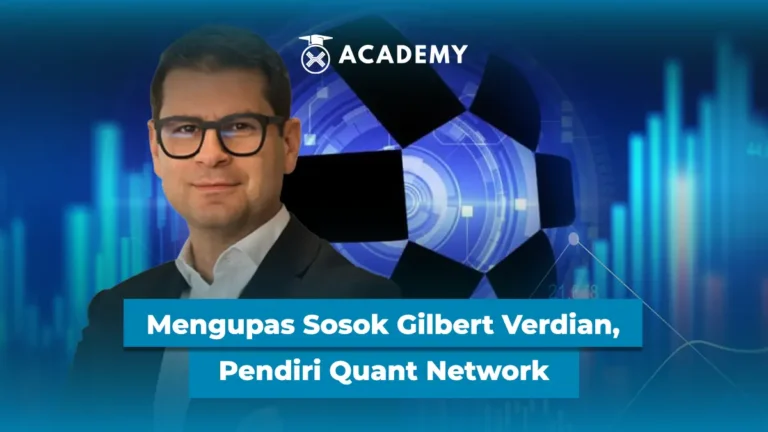Think of smart contracts as automated machines that can work on their own without the need for human control. However, there is one major obstacle, namely that they do not have direct access to information from the outside world.
This is where the role of blockchain oracles becomes important. Oracles function as data bridges that connect blockchain systems with external data, such as market prices, weather conditions, or match scores.
Without the presence of oracles, smart contracts cannot function optimally due to the lack of information. However, how does this technology actually work? Let’s see the following review.
What is Blockchain Oracle?

Blockchain oracle is a system designed to bring external data, which is outside the blockchain network (off-chain), into the blockchain ecosystem (on-chain).
This technology is an important link between the real world and the blockchain system which is basically closed and cannot access information outside itself.
The main function of the oracle is to bridge the needs of smart contracts to actual data originating from outside the network. Without an oracle, smart contracts will lose their ability to respond to real-world conditions automatically and accurately.
With an oracle, smart contracts can be executed based on outside world data so that their use becomes broader and more relevant in various fields.
Examples of data that are usually brought by oracles into the blockchain include dynamic crypto asset prices, voting results in governance systems, and weather information for agricultural insurance purposes.
In addition, sports match scores can also be used in various blockchain-based prediction applications.
By providing access to these types of data, oracles become an important foundation in building intelligent, adaptive, and useful blockchain applications in real life.
How Oracles Work in Blockchain Systems
Oracles in blockchain systems act as intermediaries between external data and smart contracts.
This process begins when the oracle collects data from various trusted sources outside the blockchain, such as market data, IoT sensors, traditional banking systems, or weather services.
The collected data is still outside the blockchain or is called off-chain. In order to be used by smart contracts, the data must first go through a verification process.
In a decentralized oracle system, this verification is carried out by independent nodes called off-chain nodes.
They are tasked with taking data from external sources and ensuring its accuracy and authenticity, before being forwarded to the on-chain component, namely the oracle smart contract.
After the data is deemed valid, the oracle will send it to the blockchain (on-chain) through the smart contract that has been prepared.
This is where the data is read and used by the main smart contract to execute instructions according to previously determined provisions, namely automatically, without third-party intervention.
In order for the data submitted to be truly trustworthy, the oracle must meet three basic principles, namely accuracy, availability, and incentive mechanisms. Accuracy ensures that the data sent is in accordance with the actual conditions.
Availability ensures that data can be accessed at any time when needed. Meanwhile, the incentive mechanism is tasked with rewarding reliable data providers and penalizing those who provide incorrect information.
In practice, oracle systems can use two approaches in distributing data, namely push and pull. The push model periodically sends data from outside to the blockchain without waiting for a request.
This is suitable for data that must be updated continuously, such as crypto prices, but requires higher costs.
Meanwhile, the pull model only sends data when requested by the application, making it more economical and efficient for data that does not change too often.
With an architecture that combines the power of off-chain nodes and on-chain contracts, as well as the use of decentralized oracle networks such as Chainlink, this system addresses a major challenge known as the oracle problem.
This challenge arises because blockchain basically cannot access data outside of itself, but through oracles, this limitation can be overcome while maintaining security, transparency, and data integrity.
Types of Blockchain Oracles
Oracles in blockchain systems have various types, depending on the data source, direction of information flow, and network structure. Here are some commonly used types, including:
1. Software Oracle
Takes data from digital sources such as websites, APIs, or online servers. Suitable for information available online, such as crypto prices or market data.
2. Hardware Oracle
Connects to physical devices such as sensors, cameras, or IoT devices. Useful for bringing real-world data such as temperature, location, or environmental conditions into the blockchain.
3. Inbound Oracle
Inputs data from outside into the blockchain. Usually used so that smart contracts can respond to external information automatically.
4. Outbound Oracle
Sends data from the blockchain to an external system. For example, giving a signal to a payment system or device after a smart contract is executed.
5. Decentralized Oracle
Oracle that uses many independent nodes as data sources. The goal is to maintain the accuracy of information and prevent manipulation. The most famous example is Chainlink.
The Role of Oracles in the Crypto World & DeFi
In the crypto and decentralized finance (DeFi) ecosystem, oracles play a very important role because they enable smart contracts to make decisions based on real-world data in real-time.
Without the presence of oracles, smart contracts can only operate in a limited space within the blockchain without any connection to actual information outside the network.
One of the most obvious applications can be found in the DeFi sector, for example in the crypto asset lending system.
Here, oracles function to determine asset prices accurately so that the collateral value can be calculated correctly and the liquidation process runs according to market conditions.
Furthermore, oracles are also used in various other applications such as prediction markets, blockchain-based insurance services, and Web3 games.
In prediction markets, oracles supply data on the results of an event such as election results or match scores. While in insurance, oracles provide data on weather conditions or certain events that trigger automatic claims.
Fundamentally, oracles act as a vital link for various decentralized applications.
Without it, most dApps would lose their ability to function optimally because they cannot access critical data from outside the blockchain.
Examples of Blockchain Oracle Uses
The following projects show how oracles are used to connect blockchains with real-world data, including:
1. Chainlink
Chainlink is the largest decentralized oracle provider in the blockchain world. This project supports thousands of different applications and networks.
Its strength lies in its ability to provide real-time data securely, accurately, and reliably, from asset prices to smart contract automation.
2. Band Protocol
One alternative to oracles that is known to be efficient and low-cost. Band Protocol uses a lighter network to send off-chain data to the blockchain, making it ideal for ecosystems that have limited gas costs.
3. Augur
A decentralized prediction platform that uses oracles to provide results from real-world events, such as election results or matches.
Oracles ensure that the information is accurate so that smart contracts can process the results fairly.
4. Weather Blockchain
One example of the use of oracles is in the agricultural insurance sector. Through sensors or official data sources, weather information is sent to the blockchain using oracles.
If certain weather conditions are met, the smart contract will automatically execute the insurance claim.
Blockchain Oracle Risks & Challenges
Although oracles are essential to a blockchain system, there are a number of challenges that need to be considered, including:
1. Oracle Problem
Blockchain is designed to be trustless, but oracles rely on the reliability of external data sources. This creates a trust gap called the oracle problem.
2. Potential for Data Manipulation
Data taken from outside the blockchain (off-chain) is at risk of being falsified or manipulated, especially if the source is not credible or not closely monitored.
3. Latency
The process of retrieving, verifying, and sending data can be delayed. This can impact the timeliness of smart contract execution, especially for applications that require real-time data.
4. Centralized Oracle as a Weak Point
If the oracle is controlled by a single central entity, the system becomes vulnerable to disruption or attack. Centralized oracles can be a single point of failure in a decentralized ecosystem.
The Future of Blockchain Oracle

The future of blockchain oracles will become increasingly crucial as smart contracts are increasingly adopted in various aspects of the real world.
Various industries are now increasingly relying on smart contracts to automate processes and make decisions based on external data.
Therefore, the role of oracles as providers of accurate and trusted data is very important so that smart contracts can run properly.
The current trend in oracle technology is towards the development of more trust-minimized and decentralized systems. This aims to reduce dependence on a single data source that is vulnerable to manipulation or failure.
With a decentralized architecture, oracles are able to increase transparency and security, so that users can be more confident that the data entering the blockchain is truly valid and not manipulated.
The integration of oracles with artificial intelligence (AI) technology and physical devices such as the Internet of Things (IoT) is also growing.
Oracles not only take data from digital sources, but also from physical sensors that measure real conditions such as temperature, humidity, or location.
The combination of AI and oracles enables more intelligent and predictive data processing, expanding blockchain applications in areas such as smart agriculture, smart cities, and risk management.
The potential for oracles in the future is enormous, especially in the logistics, supply chain, weather monitoring, and electronic voting systems sectors.
In logistics and supply chains, oracles can provide real-time data on shipping status, storage temperature, and transportation conditions, which are critical to maintaining product quality.
In the weather sector, accurate data from oracles can trigger automatic insurance claims in the event of a natural disaster.
In electronic voting, oracles enable transparent and secure vote verification, increasing public trust in digital election results.
Conclusion
So, that was an interesting discussion about Oracle Blockchain: An Important Bridge Between the Real World & Crypto that you can read in full at the Crypto Academy at INDODAX Academy.
In conclusion, without the existence of oracles, blockchains will not have access to information from the real world.
Behind the sophistication and automation of smart contracts, oracles act as the main link that connects blockchains with external data.
For those of you who want to understand more about DeFi, dApps, or smart contracts, understanding how oracles work is key to understanding the future of blockchain technology.
FAQ
1.What is an oracle in blockchain?
An oracle is a system that connects blockchains with data from the real world.
2.Why are oracles important in smart contracts?
Because smart contracts need external data (such as prices) to function automatically.
3.What are examples of popular oracles?
Chainlink and Band Protocol are two widely used blockchain oracles.
4.What is the oracle problem?
Trust issues because blockchains are trustless but oracles come from outside.
5.Where are oracles used?
In DeFi, insurance, supply chain, blockchain gaming, and other sectors.





 Polkadot 9.00%
Polkadot 9.00%
 BNB 0.51%
BNB 0.51%
 Solana 4.77%
Solana 4.77%
 Ethereum 2.37%
Ethereum 2.37%
 Cardano 1.58%
Cardano 1.58%
 Polygon Ecosystem Token 2.11%
Polygon Ecosystem Token 2.11%
 Tron 2.85%
Tron 2.85%
 Market
Market


